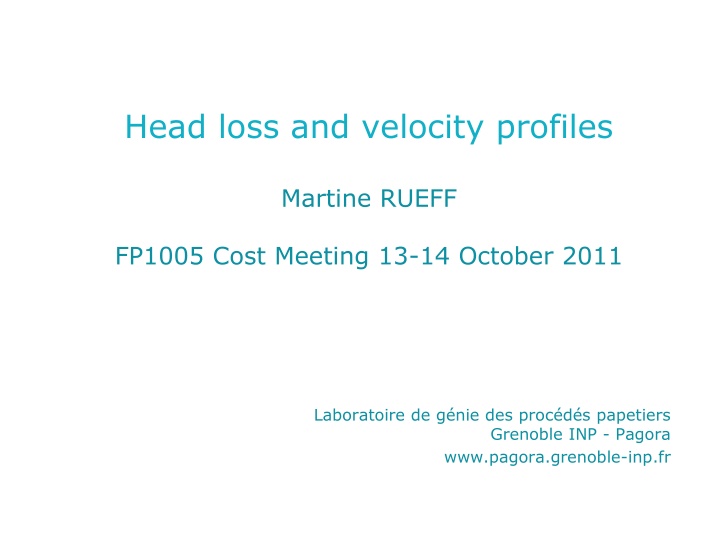
Pulp Suspension Flows and Head Loss Profiles
Explore the characterization of pulp suspension flows at low concentrations, head loss in pipes, and singularities for better insights. Discover test rigs, equipment, and behavior of fiber suspensions using advanced techniques like Pulsed Ultrasonic Doppler Velocimetry.
Download Presentation

Please find below an Image/Link to download the presentation.
The content on the website is provided AS IS for your information and personal use only. It may not be sold, licensed, or shared on other websites without obtaining consent from the author. If you encounter any issues during the download, it is possible that the publisher has removed the file from their server.
You are allowed to download the files provided on this website for personal or commercial use, subject to the condition that they are used lawfully. All files are the property of their respective owners.
The content on the website is provided AS IS for your information and personal use only. It may not be sold, licensed, or shared on other websites without obtaining consent from the author.
E N D
Presentation Transcript
Head loss and velocity profiles Martine RUEFF FP1005 Cost Meeting 13-14 October 2011 Laboratoire de g nie des proc d s papetiers Grenoble INP - Pagora www.pagora.grenoble-inp.fr
Objectives To characterise pulp suspension flows at a low concentration (consistency below 4 %) Head loss in straight pipes Head loss in singularities and to have a better insight of the suspension
Who MSc students: Ph. Dietemann (2003), L. Salgueiro (2004) PhD students: J.D. Bonfanti (1997), L. Salgueiro (2008) Interns Supervised by Martine Rueff Jean-Claude Roux
Test rigs transparent pipes 120 / 80 / 50 mm connections with smaller pipes, 17 to 40 mm, circular and rectangular cross- sections max. flow rate 180 m3/h, 2 m3storage tank transparent pipe 65 mm max. flow rate 120 m3/h, 1 m3storage tank
Test rigs Hydraulic headbox, width 50 cm, with transparent parts jet velocity up to 30 m/s 15 m3tank
Equipment - sensors Magnetic flow meters Mass flow meter Pressure sensors Differential pressure sensors Temperature sensors Pulsed ultrasound Doppler velocimeter High speed video camera / camcorder
Type of pulps Almost any pulp received in bales or liquid form stock preparation facilities waste return to the paper machine Focus on chemical pulps
Fibre suspension behaviour P/L , mbar/m Water 100 80 60 5.0 % 40 4.5 % 4.0 % 20 3.5 % 3.0 % 10 2.5 % 80 2.0 % 60 40 1.5 % 20 80 mm 10 1 2 3 4 5 10 20 40 50 100 m3/h 0.2 0.3 0.5 0.8 1.2 2.0 3.0 5.0 m/s
Pulsed Ultrasonic Doppler Velocimetry f V cos = e f f t e c
Pulsed Ultrasonic Doppler Velocimetry c = V max 2 cos f T e prf Parameters fe : transducer (size of particles) : transducer angle Tprf : time interval between two pulses Filter coefficients Other factors Refractive index of pipe wall
Pulp suspension and experimental conditions Bleached softwood pulp (maritime pine + traces of fir) 34 SR Length-weighted average length: 0.69 mm Fibre coarseness: 0.226 mg/m Consistencies: 0.47 %, 1.0 % and 2.1 % Velocities : up to 7 m/s
Experimental loop Electromagnetic flow meter : 0-180 m3/h Differential pressure sensor : 0-50 mbar
Volume fraction of fluidised suspension Velocity rp R Distance to centreline
Video images Consistency, % 0.47 1.0 2.1 Beginning of fluidisation , m/s 0.2-0.7 1.4-2.8 1.4-2.8 Limit velocity for large aggregates, m/s 0.2-0.7 1.4-2.8 2.8 Apparition of relative motion, m/s / 2.1-4.1 4.1
Conclusion PUDV: non intrusive technique Enabled us to explore a wide range of velocities and consistencies From the velocities profiles, determination of: plug size volume fraction of fluidised suspension disruptive shear stress using pressure loss measurements
Conclusion The suspension was not totally homogeneous when drag reduction occurred Video sequences showed the presence of large aggregates near the wall at relatively high velocities.
